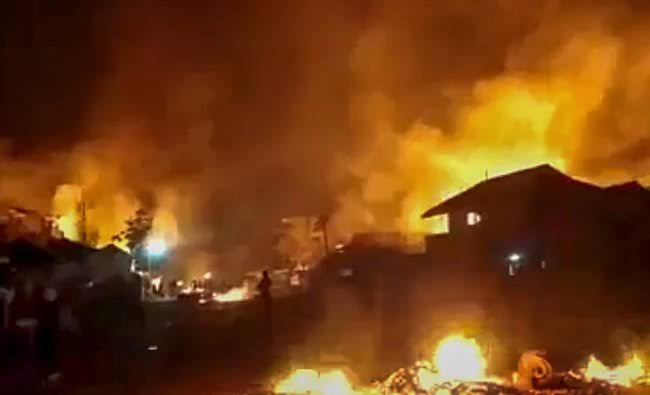Once the internet is restored, we could be in for an avalanche of visuals flowing into social media.
Sanjay Kapoor
The viral Manipur video of two women being paraded naked and molested by men amid public frenzy generated widespread outrage not just in India but around the world as well. Human rights organisations and India observers are raising serious questions on how such barbaric acts could be allowed. But, for the BJP government at the Centre, and in Manipur, the major issue isn’t the horrific incident but how the video made its way to social media.
Media Gag
Did the state government not ensure that stories of sexual violence should not escape into media? The government had smothered the media to the extent that the local press carried nothing regarding the flare-up. Social media that represents the chaos of life and is difficult to tame most of the time was also silenced by way of banning internet and more. Twitter, Facebook, YouTube had almost nothing on Manipur. This despite the fact that the incident of rape took place on May 4 and the local police with whom one of the victims had registered a complaint was completely in know of it. Shamefully, the National Commission for Women (NCW) also refused to respond to the victim’s petition. Similar to what happened in Gujarat in 2002, the state administration tactically refused to prevent the bloody conflict between the preponderantly indigenous Christians, Kukis, and Hindu Meiteis. The violence was allowed to fester. Some people have also accused the government of showing genocidal intent by allowing the majority Meitei to overwhelm the Kuki tribes in this violent faceoff.
The turbulence that has gripped the state since the last many months has resulted in the death of more than 100 people and displacement of more than 50,000. Reports of sexual violence have begun to filter in only now. All this was facilitated by obsessive ban on internet by the state government – ostensibly to maintain tranquility in the state. The impact of the internet lockdown was that it fuelled violence and disenfranchised those that did not have access to it. Since the ban was on the mobile internet, it meant that those living in the hilly areas of Manipur- Kukis – were the worst sufferers as they rely on mobile phones only. This allowed the Meiteis to have a free run when it came to dominating the narrative. It also helped block the news of those against whom violence was perpetrated. Though stray news, on a few occasions, did come out, it was buried in the national newspapers in the inner pages. Take, for instance, the horrific torching of an ambulance ferrying a mother, her son and another woman. The ambulance was escorted by the army, but they withdrew when they were confronted by a large armed mob.
A Tone-deaf New Delhi
When the video of the nude Kuki women stormed social media, it compelled Prime Minister Modi to do some lip service for the first time after the state was engulfed in the worst kind of atavistic violence. All these months, he had maintained a studied silence. Besides holding back his own views on Christian missionaries and how they support the hill tribes of Kukis or Nagas, the PM appears to want to ensure that the state does not become an issue when he goes on a globe hopping trip to US, Egypt, France and UAE. Though Manipur kept appearing in the national media due to various reasons, but the party managers succeeded to keep it low key despite the fact that Home Minister Amit Shah was on a state visit for a few days. And as a favour to those who wanted the peace to return soon, he extended his stay. In all likelihood, he knew what exactly was unfolding on ground zero. The home ministry needs to clarify whether the violent rape of the Kuki women was brought in the notice of the home minister during the visit. If he was kept in the dark, it is imperative that he made an example of those who did so – including Chief Minister N Biren Singh who claimed that the police could not do much on the rape-and-parade incident as thousands of such cases had taken place. Singh did not elaborate on the nature of the crimes or violence, but the manner in which an old rape case is tormenting the PM, all that his supporters have in response is to float conspiracy theories. It’s possible to see in the statements of his camp followers the sickening question of why the rape video has come now and not in the past. They don’t bother to take into account the fact that there was no internet and the hill people were the most impacted. The conspiracy theorists believe that foreign forces are behind it. As evidence, they point out the fact that US Ambassador Garcetti had offered to help in Manipur. Similarly, the European Union Parliament in Strasbourg had passed a resolution against government of India on the ghastly violence in the state. Interestingly, the EU resolution was taken up at a time when Narendra Modi was in France.
With the disturbing video escaping the forced censorship by the local police and pliant media, there is no guarantee that more horror does not reside in the photo and video gallery of the petrified tribals. Wonder how the government will stop the avalanche of these videos from flowing into social media when the internet is restored. Will it resort to preventing Twitter or YouTube from carrying any such videos or will it learn from the lessons of the past by first restoring peace in the state and then later attempt reconciliation between the warring communities?
A foreign policy analyst, Sanjay Kapoor is the founding editor of the New Delhi-based Hardnews magazine. He is a member of the Editors Guild of India having also served as its General Secretary.
